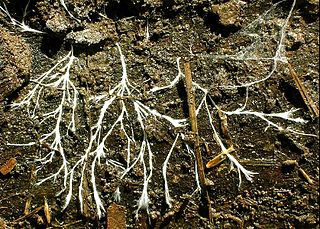Related Research Articles
The Westerdijk Institute, or Westerdijk Fungal Biodiversity Institute, is part of the Royal Netherlands Academy of Arts and Sciences. The institute was renamed on 10 February 2017, after Johanna Westerdijk, the first female professor in the Netherlands and director of the institute from 1907 to 1958. The former name of the institute was CBS-KNAW Fungal Biodiversity Centre or Centraalbureau voor Schimmelcultures. Despite the name change the collection maintained by the institute remains the CBS collections and the use of CBS numbers for the strains continues.

Lorna Ann Casselton, was a British academic and biologist. She was Professor Emeritus of Fungal Genetics in the Department of Plant Science at the University of Oxford, and was known for her genetic and molecular analysis of the mushroom Coprinus cinereus and Coprinus lagopus.

Mycelial cords are linear aggregations of parallel-oriented hyphae. The mature cords are composed of wide, empty vessel hyphae surrounded by narrower sheathing hyphae. Cords may look similar to plant roots, and also frequently have similar functions; hence they are also called rhizomorphs. As well as growing underground or on the surface of trees and other plants, some fungi make mycelial cords which hang in the air from vegetation.

Armillaria luteobubalina, commonly known as the Australian honey fungus, is a species of mushroom in the family Physalacriaceae. Widely distributed in southern Australia, the fungus is responsible for a disease known as Armillaria root rot, a primary cause of Eucalyptus tree death and forest dieback. It is the most pathogenic and widespread of the six Armillaria species found in Australia. The fungus has also been collected in Argentina and Chile. Fruit bodies have cream- to tan-coloured caps that grow up to 10 cm (4 in) in diameter and stems that measure up to 20 cm (8 in) long by 1.5 cm (1 in) thick. The fruit bodies, which appear at the base of infected trees and other woody plants in autumn (March–April), are edible, but require cooking to remove the bitter taste. The fungus is dispersed through spores produced on gills on the underside of the caps, and also by growing vegetatively through the root systems of host trees. The ability of the fungus to spread vegetatively is facilitated by an aerating system that allows it to efficiently diffuse oxygen through rhizomorphs—rootlike structures made of dense masses of hyphae.

Botryosphaeria dothidea is a plant pathogen that causes the formation of cankers on a wide variety of tree and shrub species. It has been reported on several hundred plant hosts and on all continents except Antarctica. B. dothidea was redefined in 2004, and some reports of its host range from prior to that time likely include species that have since been placed in another genus. Even so, B. dothidea has since been identified on a number of woody plants—including grape, mango, olive, eucalyptus, maple, and oak, among others—and is still expected to have a broad geographical distribution. While it is best known as a pathogen, the species has also been identified as an endophyte, existing in association with plant tissues on which disease symptoms were not observed. It can colonize some fruits, in addition to woody tissues.

The Pleosporales is the largest order in the fungal class Dothideomycetes. By a 2008 estimate it contains 23 families, 332 genera and more than 4700 species. The majority of species are saprobes on decaying plant material in fresh water, marine, or terrestrial environments, but several species are also associated with living plants as parasites, epiphytes or endophytes. The best studied species cause plant diseases on important agricultural crops e.g. Cochliobolus heterostrophus, causing southern corn leaf blight on maize, Phaeosphaeria nodorum causing glume blotch on wheat and Leptosphaeria maculans causing a stem canker on cabbage crops (Brassica). Some species of Pleosporales occur on animal dung and a small number occur as lichens and rock-inhabiting fungi.

The Mycosphaerellaceae are a family of sac fungi. They affect many common plants, such as eucalyptus, the myrtle family, and the Proteaceae. They have a widespread distribution.

Armillaria novae-zelandiae is a species of mushroom-forming fungus in the family Physalacriaceae. This plant pathogen species is one of three Armillaria species that have been identified in New Zealand.

Armillaria gallica is a species of honey mushroom in the family Physalacriaceae of the order Agaricales. The species is a common and ecologically important wood-decay fungus that can live as a saprobe, or as an opportunistic parasite in weakened tree hosts to cause root or butt rot. It is found in temperate regions of Asia, North America, and Europe. The species forms fruit bodies singly or in groups in soil or rotting wood. The fungus has been inadvertently introduced to South Africa. Armillaria gallica has had a confusing taxonomy, due in part to historical difficulties encountered in distinguishing between similar Armillaria species. The fungus received international attention in the early 1990s when an individual colony living in a Michigan forest was reported to cover an area of 15 hectares, weigh at least 9.5 tonnes, and be 1,500 years old. This individual is popularly known as the "humongous fungus", and is a tourist attraction and inspiration for an annual mushroom-themed festival in Crystal Falls. Recent studies have revised the fungus's age to 2,500 years and its size to about 400 tonnes, four times the original estimate.

The Harry Oppenheimer Fellowship Award is awarded annually by the Oppenheimer Memorial Trust. It is considered the top award for research on the African continent.

Armillaria root rot is a fungal root rot caused by several different members of the genus Armillaria. The symptoms are variable depending on the host infected, ranging from stunted leaves to chlorotic needles and dieback of twigs and branches. However, all infected hosts display symptoms characteristic of being infected by a white rotting fungus. The most effective ways of management focus on limiting the spread of the fungus, planting resistant species, and removing infected material. This disease poses a threat to the lumber industry as well as affecting recreational areas.

Alma Joslyn Whiffen-Barksdale was an American mycologist who discovered cycloheximide. She was born in Hammonton, New Jersey. She received a bachelor's degree from Maryville College (1937). Her Masters and Ph.D. were earned at the University of North Carolina. In 1941–42. She was a Carnegie Fellow, and in 1951, she was a Guggenheim Fellow. Barksdale worked at the Department of Antibiotic Research of the Upjohn Company of Kalamazoo, Michigan (1943–52) and at the New York Botanical Garden. Barksdale became a foundational figure in the study of Achlya, a genus of aquatic fungi with a unique reproductive system, while working at the New York Botanical Garden; The Mycological Society of America and the Achlya Newsletter, a publication of continuing research on Achlya, both published retrospectives on her life and work following her death in 1981.

Teratosphaeriaceae is a family of fungi in the order Capnodiales.

Johanna Westerdijk was a Dutch plant pathologist and the first female professor in the Netherlands.

Glomerellales is an order of ascomycetous fungi within the subclass Hypocreomycetidae (Sordariomycetes). The order includes saprobes, endophytes and pathogens on plants, animals and other fungi with representatives found all over the world in varying habitats.
Pedro Willem Crous is a South African mycologist and plant pathologist.

Rosemary E. Bradshaw is a New Zealand mycologist, as of 2019 full professor of genetics at the Massey University.
Michael John Wingfield is a South African academic and scientist who studies plant pathology and biological control. He was the founding director of the Forestry and Agricultural Biotechnology Institute, University of Pretoria. Wingfield has authored or co-authored over 1000 scientific publications and is considered a leading expert in the field of forest health and invasive species. He has received numerous awards and honours throughout his career, including Harry Oppenheimer Fellowship Award in 2022. He is also a Fellow of the Royal Society of South Africa and the African Academy of Sciences. Wingfield has had several fungi named after him.
Sarcostroma is a genus of fungi in the family Sporocadaceae. Most species of this genus are saprobes, endophytes or pathogens on leaves.
References
- ↑ "Michael J. Wingfield". Michael J. Wingfield. Retrieved 26 December 2022.
- 1 2 3 4 Butler-Adam, John (26 July 2016). "Harry Oppenheimer Fellowship Awards, 2016". South African Journal of Science. 112 (7/8): 2. doi: 10.17159/sajs.2016/a0164 . ISSN 0038-2353.
- 1 2 3 Grant-Marshall, Sue (1 July 2016). "Winning Women: A passion for trees". CityPress. Retrieved 19 January 2020.
- 1 2 "Professor Brenda Wingfield". University of Pretoria. Retrieved 29 March 2017.
- ↑ "Professor Brenda Wingfield". African Centre for Gene Technologies. Retrieved 29 March 2017.
- ↑ "2015 – Brenda Wingfield". The Oppenheimer Memorial Trust. Retrieved 19 January 2020.
- ↑ T. C. Harrington and B. D. Wingfield (1995). "A PCR-Based Identification Method for Species of Armillaria". Mycologia. 87 (2): 280–288. doi:10.1080/00275514.1995.12026531. JSTOR 3760915.
- ↑ Irene Barnes; Pedro W Crous; Brenda D Wingfield; Michael J Wingfield (2004). "Multigene phylogenies reveal that red band needle blight of Pinus is caused by two distinct species of Dothistroma, D. septosporum and D. pini". Studies in Mycology . 50 (2): 551–565.
- ↑ Karin Jacobs; Dale R. Bergdahl; Michael J. Wingfield; Shari Halik; Keith A. Seifert; Donald E. Bright; Brenda D. Wingfield (April 2004). "Leptographium wingfieldii introduced into North America and found associated with exotic Tomicus piniperda and native bark beetles". Mycological Research. 108 (4): 411–418. doi:10.1017/S0953756204009748. PMID 15209281.
- ↑ Duvenage, Engela (10 July 2014). "A life dedicated to fungi - and academics". SciBraai. Retrieved 19 January 2020.
- ↑ "Brenda Wingfield". The Conversation. Retrieved 29 March 2017.
- 1 2 "Two more international accolades for Prof Brenda Wingfield". University of Pretoria. 2 August 2017. Retrieved 19 January 2020.
- ↑ "Prof Brenda Wingfield wins NSTF award". Forestry South Africa. 7 July 2014. Retrieved 19 January 2020.
- ↑ "Brenda Wingfield receives the Harry Oppenheimer Memorial Fellowship award". FABI. Retrieved 29 March 2017.